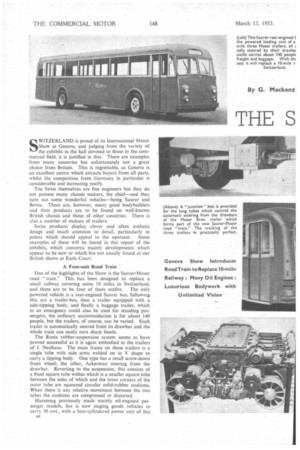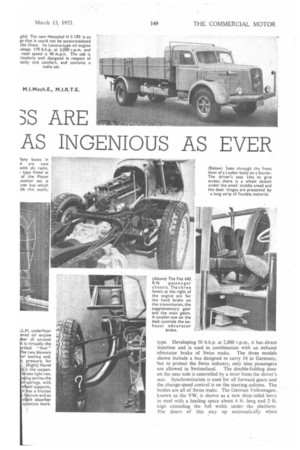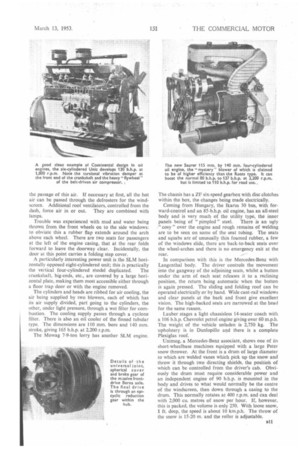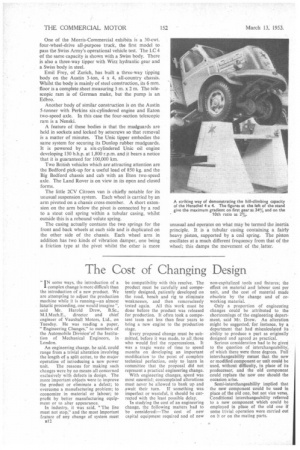THE S $S ARE AS INGENIOUS AS EVER
Page 42

Page 43

Page 44

Page 45

Page 46

If you've noticed an error in this article please click here to report it so we can fix it.
By G. Mackenz
M.I.Mech.E.,
SWITZERLAND is proud of its International Motor Show at Geneva, and judging from the variety of the exhibits in the hall devoted to those in the commercial field, it is justified in this. There are examples from many countries but unfortunately not a great choice from Britain. This is regrettable, as Geneva is an excellent centre which attracts buyers from all parts, whilst the competition from Germany in particular is considerable and increasing yearly.
The Swiss themselves are fine engineers but they do not possess many chassis makers, the chief—and they turn out some wonderful vehicles—being Saurer and Berna. There are, however, many good bodybuilders and their products are to be found • on well-known British chassis and those of other countries. There is also a number of makers of trailers.
Swiss products display clever and often esthetic design and much attention to detail, particularly in points which should appeal to the operator. Some examples of these will be found in this report of the exhibits, which concerns mainly developments which -appear to be new or which itre not usually found at our British shows at Earls Court.
A Four-unit Road Train ' One of the highlights of the Show is the Saurer,Moser road " train." This has been designed to replace a small railway covering some 10 miles in Switzerland, and there are to be four of these outfits. The only powered vehicle is a rear-engined Saurer bus, following. this are a trailer-bus, then a trailer equipped with a side-tipping body, and finally a baggage trailer, which in an emergency could also be used for standing passengers, the ordinary accommodation is for about 140 people, but the trailers, of course, can be varied. Each trailer is automatically steered from its drawbar and the whole train can easily turn sharp bends.
The Rosta rubber-suspension system seems to have proved successful as it is again embodied in the trailers of J. Neuhaus. The main frame on these trailers is a single tube with side arms welded on in V shape to carry a tipping body. One type has a small screw-down front wheel; the other, Ackerman steering from the drawbar. Reverting to the suspension, this consists of a fixed square tube within which is a smaller square tube between the sides of which and the inner corners of the outer tube are squeezed circular solid-rubber cushions. When there is any relative movement between the two tubes the cushions are compressed or distorted.
Hanomag previously made mainly oil-engined passenger models, but is now staging goods vehicles to carry 30 cwt., with a four-cylindered power unit of this nit
type. Developing 50 b.h.p. at 2,800 r.p.m., it has direct injection and is used in combination with an exhaust obturator brake of Swiss make. The three models shown include a bus designed to carry 14 in Germany, but to protect the Swiss industry, only nine passengers are allowed in Switzerland. The double-folding door on the near side is controlled by a lever from the driver's seat. Synchronization is used for all forward gears and the change-speed control is on the steering column. The bodies are all of Swiss make. The German Volkswagen, known as the VW, is shown as a new drop-sided lorry in steel with a loading space about 4 ft. long and 2 ft. high extending the full width under the platform. The doors of this stay up automatically when lifted. This construction is permitted by the use of a rear engine. A similar model is shown as a Coca-Cola shop with lifting sides, except for narrow sections which swing down for serving.
New to the Swiss Show, although thousands are . operating in France, is the Citroen " 45 " 8-tonner. This has a six-eylindered Citroen oil engine with LavaletteBosch pump, Lockheed hydraulically operated brakes with compressed air boosters and an air-cooled disc-type hand-brake behind the centre cross-member.
Renault has a new under-floor-engined lorry with double-reduction axles and a torque-tube stabilizer at the rear. Another 4 x 4 is built as an ambulance for the Swiss army. It is all-steel and has side doors which fold up to permit the use of four stretchers. On a similar chassis is a general service lorry body. A feature of all these vehicles is a stout steel plate mounted at an angle before the front axle to prevent the nose digging into soft ground.
Labourier has a 4 x 4 built under F.W.D. licence. It embodies a Unic 135 b.h.p. oil engine, Westinghouse air brakes and a lock for the central differential.
Amongst new German vehicles is the Lloyd with a two-cylindered two-stroke air-cooled engine of 386 c.c. With its front-wheel-drive this is shown as a combination type to carry six people, but the rear seats are removable for goods transport. Mainly constructed in steel, the panels below the windows are of polished wood and there is a large single rear door.
Points about the Fiat 642 N 5-tonner are a directinjection, 92-b.h.p. engine and gearing giving eight speeds forward and two reverse. The highest speed is 62 k.p.h. It can climb 27.2% grades fully loaded.
Intriguing on the 642 RN passenger model is the number of control levers; these are for the hanct.brake, supplementary gear, main gears and the obturator exhaust brake. This brake is neatly fitted between the exhaust manifold and pipe. In the centre of the steering wheel are inner and outer buttons, one for the horn, the other for headlight flicking at night.
Draize builds trailers up to 50 tons, but on show are a 5-tonner with Draize tipping gear, a four-wheeled 10-tonner and a two-wheeler. All are exceptionally strongly built, with air-pressure braking, whilst the largest has Dunlop rubber mudguards.
el 0
A new coach is the Alpine type built by E. Fliiclager on a Bema-assembled O.M. With the folding roof slid back there is practically perfect visibility, as all the roof panels are in clear plastic. In addition there nre large roof ventilation panels at the front and rear which are operable hydraulically from the driver's seat, the neat lifting mechanism is a small ram.
Another novelty lies in the gangway seats; when unoccupied these lift slightly and move towards the outer seats, thus clearing the gangway, but they move into it again immediately the passengers sit down. The upholstery is carried out in a plastic called Stanoid, which is claimed to be more easily cleaned than leather and never changes colour.
On a forward-control Saurer is a 30-seat Gangloll body in which the seats move into the gangway in pairs. The whole of the rear part of the body can be removed in 30 min. to substitute one for goods. This involves removing six screws along the sides and the roof, and eight on the floor. Rather than use dark plastic which
may obscure the view, the maker employs light green plastic, with spring blinds for use when the sun is strong.
There has been much difficulty in obtaining sufficient heating from an oil engine; this has been overcome in this coach by using thick rubber blinds iii front of the radiator and even cork insulation for its tanks, whilst Saurer engines now have thermostats. Fresh air is brought in at the side of the vehicle through a heater block and discharged down the body. The roof rear ventilator can be kept open even in the rain because of
the passage of this air. If necessary at first, all the hot air can be passed through the defrosters for the windscreen. Additional roof ventilators, controlled from the dash, force air in or out. They are combined with lamps.
Trouble was experienced with mud and water being thrown from the front wheels on to the side windows: to obviate this a rubber flap extends around the arch above each wheel. There are two seats for passengers at the left of the engine casing, that at the rear folds forward to leave the doorway clear. Incidentally, the door at this point carries a folding step cover.
A particularly interesting power unit is the SLM horizontally opposed eight-cylindered unit; this is practically the vertical four-cylindered Model duplicated. The crankshaft, big-ends, etc., are covered by a large horizontal plate, making them most accessible either through a floor trap door or with the engine removed.
The cylinders and heads are ribbed for air cooling, the air being supplied by two blowers, each of which has its air supply divided, part going to the cylinders, the other, under light pressure, through a wet filter for combustion. The cooling supply passes through a cyclone filter. There is also an oil cooler of the finned tubular type. The dimensions are 110 mm. bore and 140 mm. stroke, giving 165 b.h.p. at 2,200 r.p.m.
The Mowag 7-9-ton lorry has another SLM engine. The chassis has a ZF six-speed gearbox with disc clutches within the box, the changes being made electrically.
Coming from Hungary, the Ikarus 30 bus, with forward-control and an 85-b.h.p. oil engine, has an all-steel body and is very much of the utility type, the inner panels being of " pimpled " steel. There is an ugly ," cosy" over the engine and rough remains of welding are to be seen on some of the seat tubing. The seats and squabs are of unusually thin foamed rubber, a few of the windows slide, there are back-to-back seats over the wheel-arches and there is no emergency exit at the rear.
In comparison with this is the Mercedes-Benz with Langenthal body. The driver controls the movement into the gangway of the adjoining seats, whilst a button under the arm of each scat releases it to a reclining position, the return being automatic when the button is again pressed. The sliding and folding roof can be operated electrically or by hand. Wide cant-rail windows and clear panels at the back and front give excellent vision. The high-backed seats are narrowed at the head for the same reason.
Lauber stages a light chassisless 14-seater coach with a 106 b.h.p. Chevrolet petrol engine giving over 60 m.p.h. The weight of the vehicle unladen is 2,750 kg. The upholstery is in Dunlopillo and there is a complete Plexiglas roof.
Unimog, a Mercedes-Benz associate, shows one of its short-wheelbase machines equipped with a large Peter snow thrower. At the front is a drum of large diameter to which are welded vanes which pick up the snow and throw it through two directing shields, the positioh of which can be controlled from the driver's cab. Obviously the drum must require considerable power and an independent engine of 90 b.h.p. is mounted in the body and drives to what would normally be the centre of the windscreen, then down through a casing to the drum. This normally rotates at 400 r.p.m. and can deal with 2,000 Cu. metres of snow per hour. If, however, this is packed, the volume is only 250. With loose snow, 1 ft. deep, the speed is about 10 km.p.h. The throw of the snow is 15-20 m. and the roller is adjustable.
One of the Morris-Commercial exhibits is a 30-cwt. four-wheel-drive all-purpose truck, the first model to pass the Swiss Army's operational vehicle test. The LC 4 of the same capacity is shown with a Swiss body. There is also a three-way tipper with Wirz hydraulic gear and a Swiss body in steel.
Emil Frey, of Zurich, has built a three-way tipping body on the Austin 3-ton, 4 x 4, all-country chassis. Whilst the body is mainly of steel construction, its 6 mm. floor is a complete sheet measuring 3 m. x 2 m. The telescopic ram is of German make, but the pump is an Edbro.
Another body of similar construction is on the Austin 5-tonner with Perkins six-cylindered engine and Eaton two-speed axle. In this case the four-section telescopic ram is a Nenski.
A feature of these bodies is that the mudguards are held in sockets and locked by setscrews so that removal is a matter of minutes. The Unic tipper embodies the same system for securing its Dunlop rubber mudguards. It is powered by a six-cylindered Unic oil engine developing 130 b.h.p. at 1,800 r.p.m. and it bears a notice that it is guaranteed for 100,000 km.
Two British vehicles which are attracting attention are the Bedford pick-up for a useful load of 850 kg. and the Big Bedford chassis and cab with an Eton two-speed axle. The Land Rover is on view in its open and closed forms.
The little 2CV Citroen van is chiefly notable for its unusual suspension system. Each wheel is carried by an arm pivoted on a chassis cross-member. A short extension on the arm below the pivot is connected by a rod to a stout coil spring within a tubular casing, whilst outside this is a rebound volute spring.
The casing actually contains the two springs for the front and back wheels at each side and is duplicated on the other side of the chassis. Each wheel arm in addition has two kinds of vibration damper, one being a friction type at the pivot whilst the other is more unusual and operates on what may be termed the inertia principle. It is a tubular easing containing a fairly heavy piston, supported by a coil spring. The piston oscillates at a much different frequency from that of the wheel; this damps the movement of the latter.




















































































